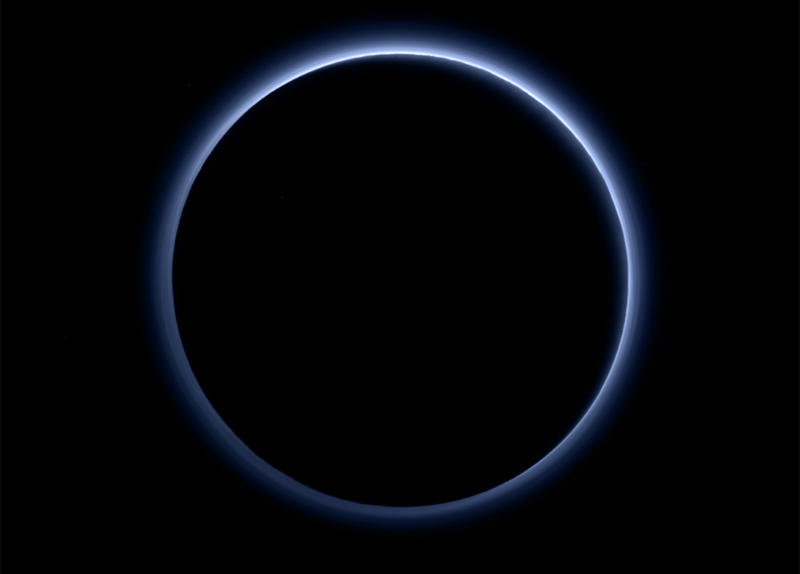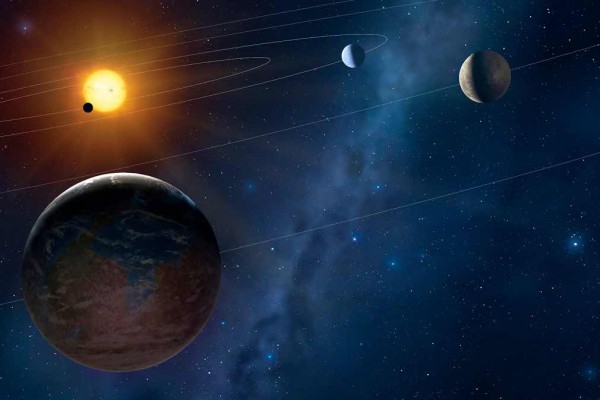Pluto hasn’t been on the public radar since it was demoted to a dwarf planet in 2006. It turns out the dwarf planet is still full of surprises. NASA announced today that the ice ball contains patches of frozen water and blue skies.
NASA made the announcement today by releasing a photo of Pluto’s cerulean halo, which was taken in July by the New Horizons spacecraft. The space agency originally tickled the public’s interest by stating it was about to make an amazing announcement about Pluto and described the planet as “alive.”[1,2]
Describing the planet as “alive” was a bit of an exaggeration on NASA’s part. Nevertheless, the released photo did rejuvenate public interest in the dwarf planet. Rather than looking like an image of a celestial ball of ice occupying the outskirts of the solar system, Pluto now appears to be much more similar to Earth.
“Who would have expected a blue sky in the Kuiper Belt? It’s gorgeous,” said Alan Stern New Horizons principal investigator from Southwest Research Institute (SwRI), Boulder, Colorado, in a statement. The blue in the newly released photos will enable scientists to consider how exactly the dwarf planet formed.[1]
Earth no longer the only blue planet in town
Just like Earth, Pluto’s blue sky is caused by tiny particles scattering the planet’s atmosphere, which disperses visible light from the sun. Dispersing shorter wavelengths is what makes Earth shine blue.
The tiny particles that scatter Pluto’s atmosphere are known as tholins. The haze particles that pervade Earth’s atmosphere are relatively small. The haze particles on Pluto are larger than Earth’s, but still relatively small.[1]
Tholins are created by ultraviolet radiation breaking down nitrogen and methane molecules. It is the same chemical process found on Saturn’s moon, Titan.
The particles aren’t intrinsically blue, however. In actuality, they have a red/grey tint and are heavy enough to fall from the graces of heaven and bombard the planet’s surface.
Small patches of frozen water dot Pluto’s surface
The space agency also discovered that Pluto had small patches of ice on its surface. The bits of ice discovered were tightly correlated with red spots that blanketed the planet.
You might suspect that frozen water would coat the surface of a planet on the frigid outskirts of the solar system. On the contrary, the makeup of Pluto mostly consists of gases like vapor. Scientists were therefore shocked to discover frozen patches of ice were sprinkled throughout the surface.
The New Horizons Team suggests there might be some sort of relationship between the surface ice on Pluto and the atmospheric particles that paint blotches of the sky blue, though mysteries still remain. The water only appears in isolated patches. Scientists are speculating about how and when those patches formed.[2]
“I’m surprised that this water ice is so red,” says Silvia Protopapa, a science team member from the University of Maryland, College Park. “We don’t yet understand the relationship between water ice and the reddish tholin colorants on Pluto’s surface.”[1]
These findings come less than two weeks after NASA announced it had discovered flowing water on the surface of Mars. The discovery that ice water dots a planet’s surface occurs once in a blue moon; and in this particular case, once in a blue planet. Perhaps Earth is not as special as previously believed.
Find more articles on planets, stars and new space discoveries at AlternativeNews.com
Sources include:
[1] Independent.co.uk
[2] Wired.com
















